DMZ and JSA
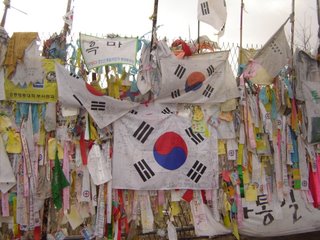
Ever since arriving in Korea, one of the things that most interested us was the tour of the DMZ (Demilitarized Zone), and, in particular, the JSA (Joint Security Area), also known as Panmunjeom. The events which unfolded a couple of months back piqued our interest even further.
The DMZ stretches for 241 kilometres across the waist of the peninsula, and was established at the end of the Korean war. While the area south of this zone is hyper-militarized, the DMZ itself is essentially a no-man's land. Aside from Panmunjeom, the area consists of barbed wire fencing, guard posts, and patrolling mobile units. Also, within this area, are two villages, one in the North, and one in the South. Of course, the South Koreans refer to these two villages as "Freedom Village" (South), and "Propaganda Village" (North), and I would imagine the North Koreans swap these names around.
Our tour guide briefed us on the weight and importance of this tour, and informed us of a few things to adhere to in order to avoid jeopardizing the proceedings. For instance, once inside Panmunjeom, we were not allowed to point at anything. If North Korean guards thought our fingers were a gun, they were liable to shoot us. Also, we were to refrain from any interaction with the "other side" whatsoever; if they waved, we were under orders not to acknowledge it in any way. Many of the rules stemmed from the possibility that many things can be twisted into some kind of propaganda by the North. Up until recently, there was a strict dress code involved on these tours which prohibited the wearing of jeans, as North Korea viewed the wearing of jeans as a sign of poverty, and used this in propaganda regarding how poor the South was.
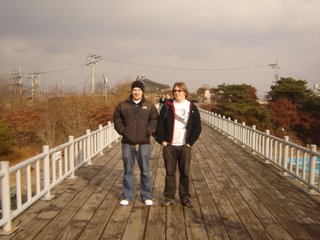
Our first stop on the tour was "Freedom Bridge" at Imjingak. After the armistice of 1953 , over 13,000 prisoners of war crossed this bridge, regaining their freedom in the South. The picture at the top of this post is an assortment of tributes at the far side of the bridge. These offerings and messages are left by South Koreans, hopeful of unity with the North, as Koreans are not permitted to go any further. The DMZ tours are open to foreigners only. If unity should ever happen in the future, the railroad at this point is just waiting to be connected to the North. You can see I relented to the bitter cold recently, and joined the ranks of the Korean puffer coat brigade. Nice!
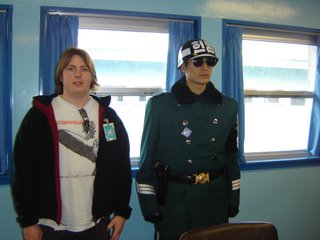
Here is Northy getting cosy with a South Korean guard in the main conference building. These guys are required to be at least six feet tall, and a black belt in taekwondo. They wear these glasses at all times to hide their eyes. I'm guessing they're pretty handy in a scrap. And if not, they have guns anyway.
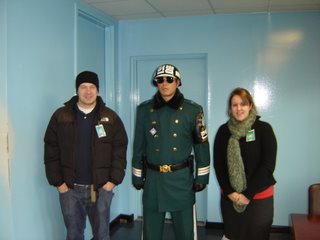
Through the centre of this conference room, where all major meetings and discussions take place, runs the border line. In fact, the border runs exactly through the centre of the microphone on the central table, and is the only place where you can freely step into North Korea, and just as freely step back again. The symbolic actions which have occurred in this room, are sometimes dampened by the ludicrous acts of pettiness which have blighted attempts at reconciliation over the years. One day, a flag was brought in by one side that was slightly larger than the flag of the other. At the next meeting, this smaller flag was replaced by a flag larger than that of the other side. On alternate meeting days, the respective sides brought in continually larger flags until the flags were too big to bring inside the building. Similarly, the North Koreans added a third story to their main building, to be higher than the building in the South. And wait until you see the size of the flagpole further down.
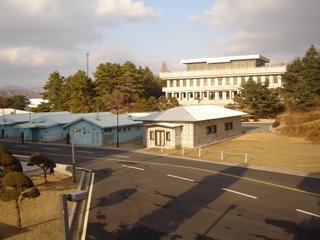
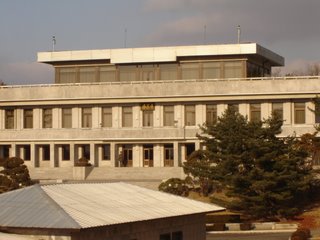
(There's a North Korean guard. Go on, give him a wave!)
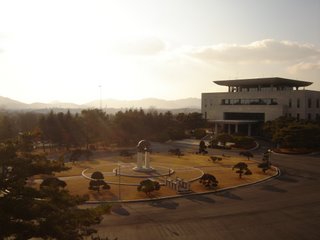
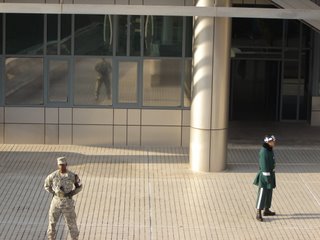
(An American guard and a Korean guard. Our escorts for the day. Not the most jovial people you'll ever meet, but given the circumstances we can let them off)
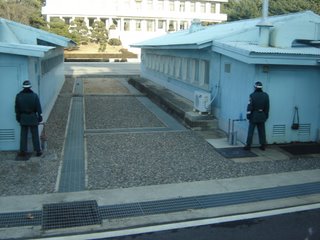
(The Korean guards all stood, facing the North side, half hidden behind the corners of each building. This looked very strange, like the ending of Blair Witch. The reason for this was to present less of a target should someone get an itchy trigger finger on the other side.

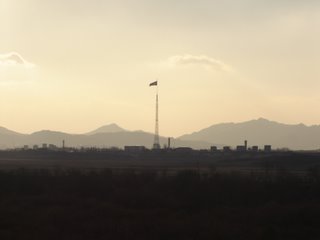
As I mentioned earlier, there are two villages within the DMZ. The village in the South has a 100 metre tall flagpole, while the village in the North, as pictured above, has a pretty impressive 160 metre high flagpole. Rumour has it, that "Propaganda Village" has no permanent residents, and maintenance workers and farmers from nearby Gaeseong are bused in every day to create a lived-in appearance, and then taken home at night. Children are also brought in to play, and the lights are all switched on and off automatically, all to give the impression of this wonderful life in the North.
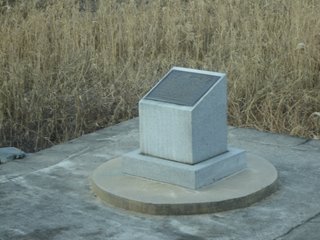
The last stop on the tour, was the "Bridge of No Return". This area achieved notoriety after the axe murders which took place in 1976. While cutting down a tree impeding the view of the guard post, civilian workers and their armed guards were besieged by a truckload of North Korean soldiers wielding clubs and axes. As a result of this vicious attack, two U.S Army captains were axed to death. This marker shows the position of the tree. If you've ever seen the Korean movie J.S.A, you'll probably recognize this bridge.
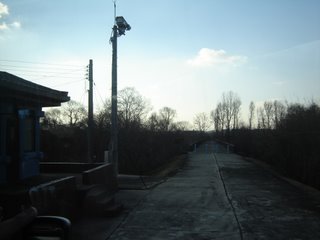
After the tour, we bought some toxic North Korean wine, which we have saved until Xmas Day. It's been quite a struggle holding off drinking sediment filled 18% wine that smells like a fat man's crotch, but it's now the 22nd, so we're almost there. We then went out in Hongdae in Seoul, and I got ill and poofed off home. Gotta be the first time ever! Here's me feeling sick, and Northy trying to molest some locals.
Cheerio!
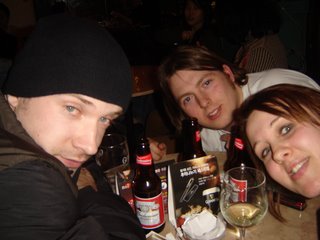
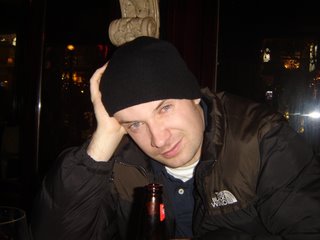
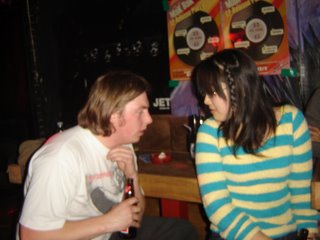
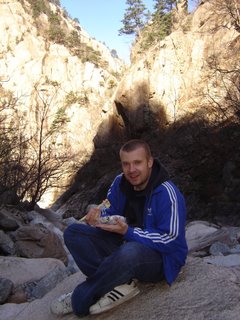

0 Comments:
Post a Comment
<< Home